I’m a grouse hunter. I raise pointers that are highly competitive in grouse trials. I train grouse dogs, and I even wrote a book titled Building a Grouse Dog, but I have a confession to make – I have had a long and passionate relationship with woodcock. One might suggest that I actually cheat on the ruffed grouse. I don’t really think of it as cheating – I have a very open relationship with grouse hunting and woodcock are so available. It makes them hard to resist. Of all my grouse covers, and that’s a pretty big number, I can only think of a very few that don’t also hold woodcock most of the time. And by most of the time, I mean from the first arrival of males claiming singing grounds in the spring until the last woodcock heads south usually before the end of the actual season on November 14th. Even in the winter when I flee to Kentucky with a bunch of dogs, I end up finding woodcock from the end of January through my departure near the end of March when I head back north for the Southern New England Woodcock Championship in Rhode Island.
They are the penultimate training bird for developing wild bird dogs. Where a brood of grouse might be in one of my summer training covers one day, they won’t necessarily be there the next or even the next week. Woodcock on the other hand tend to stay in a cover for the entire summer and will usually be relatively close to the spot where you found them previously. This is not to say that if you overwork them, they won’t be pushed out. But for the most part the birds stay close to where they were born and can be pointed over and over during summer training. This is especially beneficial for my younger dogs that are still learning the game.
As much as I like woodcock for a training bird, I truly look forward to shooting woodcock in the fall, especially for those same young dogs. The first woodcock I shot was almost by accident about 40 years ago. I was paralleling an old stone wall in a long-overgrown pasture choked with apples and alders. I was without a dog and my 12-gauge pump was at port arms. It was a spot where I had flushed a few partridges in the past. (In my neck of the woods, if you don’t have a dog you hunt partridge. Grouse are birds that must be pointed and shot on the wing.) I’d take a step or two and then stop, always scanning along the wall and under the apples for birds. Still hunting in the manner of a deer hunter as described in the classic booklets by William Claflin, Partridge Rambles (1934) and Partridge Adventures (1951) and republished together in 2014 as a limited edition of 250 copies by the Wolfe Publishing Company.
for those same young dogs. The first woodcock I shot was almost by accident about 40 years ago. I was paralleling an old stone wall in a long-overgrown pasture choked with apples and alders. I was without a dog and my 12-gauge pump was at port arms. It was a spot where I had flushed a few partridges in the past. (In my neck of the woods, if you don’t have a dog you hunt partridge. Grouse are birds that must be pointed and shot on the wing.) I’d take a step or two and then stop, always scanning along the wall and under the apples for birds. Still hunting in the manner of a deer hunter as described in the classic booklets by William Claflin, Partridge Rambles (1934) and Partridge Adventures (1951) and republished together in 2014 as a limited edition of 250 copies by the Wolfe Publishing Company.
It was during these frequent pauses that the grouse would get nervous and flush. It still works when flushing in front of a dog. Just as you stop going forward about to give up in despair, a grouse will thunder out leaving you just milliseconds to get your gun up and on target. This day, however, the grouse were not along the wall or under the apples, and after what would be my last pause before turning out of the pasture and heading home, I took a step forward and a funny looking brown and russet bird with a long beak fluttered up in front of me. At first, I did nothing. Then somewhere in the back of my predatory brain an electrical impulse sent the message – WOODCOCK. My gun came up and I sent a load of 7 1/2s flying after the bird and its whistling wings as it passed through an opening in the surrounding brush. Much to my amazement the bird dropped from the sky like a stone and I walked over to where it lay.
When I picked it up, I didn’t know if it was a male or a female, or for that matter if it really was a woodcock as I had never seen one up close before. My only experience had been hearing them peenting in the spring in the field behind our house and watching their mating flight as dusk turned to darkness. I couldn’t think what else it could be, so I put it in my vest and headed home. My trusty Peterson’s Birds of North America confirmed what I already believed to be true and from his description it appeared I had shot a male. Today, it would be easy to look up a recipe on the internet for preparing woodcock for the table but 40 years ago we were still living with landlines and books and there wasn’t one in our kitchen with a woodcock recipe. I decided I’d try cooking it like a grouse and easily breasted out the little bird and then proceed to overcook it until it was tough and chewy.
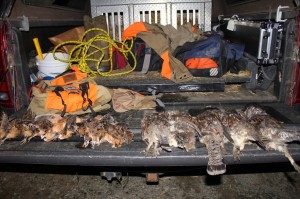 I would later learn how to cook woodcock so that the lightly seared breasts with a highbush cranberry jelly reduction sauce were a culinary treat often served as an appetizer before a more substantial grouse camp meal of steak or double thick pork chops. Probably calling it grouse camp is a bit of a misnomer. There is nothing very campy about my house except for its location in the middle of 100 acres that have been managed to be one of the best grouse and woodcock covers we hunt. We try not to shoot many of the house grouse as they are valuable as training birds for next year’s puppies, but the flight birds that filter through in October are fair game. A perfect example of this was late on Thursday afternoon in the third week of October. A party of my regular clients had hunted hard all day going up and down mountainsides following their own dogs as well as a few of mine.
I would later learn how to cook woodcock so that the lightly seared breasts with a highbush cranberry jelly reduction sauce were a culinary treat often served as an appetizer before a more substantial grouse camp meal of steak or double thick pork chops. Probably calling it grouse camp is a bit of a misnomer. There is nothing very campy about my house except for its location in the middle of 100 acres that have been managed to be one of the best grouse and woodcock covers we hunt. We try not to shoot many of the house grouse as they are valuable as training birds for next year’s puppies, but the flight birds that filter through in October are fair game. A perfect example of this was late on Thursday afternoon in the third week of October. A party of my regular clients had hunted hard all day going up and down mountainsides following their own dogs as well as a few of mine.
There was plenty of daylight left so we headed for the home cover which is not only managed for birds but laced with cut trails and small mowed fields that create great edges for both woodcock and grouse and easy walking. As was often the case that season, grouse were tough to come by and my dog Jonathan (named after the apple variety) only got one grouse pointed. However, the “house grouse” are well educated, and no one got a shot at this one. But the flight birds were in and Jonathan staunchly pointed five of which a couple made it in the game bag. They topped off a day where we had flushed only 7 grouse but 16 woodcock finds provided plenty of shooting opportunities and enough birds in the bag for a good “hero shot” on the tailgate at the end of the day.
I will tell anyone who asks that both the grouse and woodcock limits in October are a cruel joke. It’s extremely difficult in our area to shoot four grouse in a day if you are only shooting pointed birds, whereas if you catch a flight of woodcock it is nothing to shoot a limit of three in the first cover of the morning. I actually did it once on two finds, shooting a double on the first find and then a single. Three shots and I was done for the day. Well at least done shooting at them. On days like that I’ll carry a blank gun as well as my shotgun or if my blank gun is back in the truck just fire a round in a safe direction away from the fleeing woodcock and the pointing dog. The dog expects the shot and I like the smell of gun powder, besides shells used to be the cheapest part of bird hunting.
Fortunately, I guess, woodcock are usually somewhat harder to hit and my shooting often tends towards mediocre so mornings like the one described above are truly rare. However, if the flights are in, a three-bird limit is pretty easy which is why we save our best woodcock covers for the young dogs. I got my first pointing dog in 1987 – a Brittany – and then switched to setters and then finally to pointers but that’s a story for another time. My last setter was a dog named Chuckie and his picture is still on our refrigerator. In his first hunting season we targeted lots of woodcock with him and he quickly became a bit of a savant on the little birds. Like so many field trial dogs, Chuckie was registered by the breeder as born on January 3, 1995 which would make this part of the story about 25 years ago.
It was near the end of the day and we had saved one last cover for Chuckie. It lay along the river not far from the house and was a combination of mature trees and clumps of alders and scrubby chokecherries. It was, once you came down the hill, a big flat on the bend of the river. Almost as soon as he hit the flat Chuckie was on point. As we walked to him, we bumped two woodcock and then two got up in front of him. As a puppy he was still allowed to break on the shot and was quickly on point again. Another bird was walked up and another was in front of the dog. That was six woodcock in about that many minutes. I honestly don’t know how many birds we walked up and flushed in front of the dog. Enough so that we both limited out in that one cover and were just firing into the quickly darkening sky as Chuckie kept pointing bird after bird. When I could see the fire flaring out of barrels, (I was shooting a 20-gauge O/U at that point) I walked up to the dog on point and snapped the lead on him. It was the only way I was going to catch him.
I think he pointed somewhere between 15 and 20 times with multiple birds flushed in front of him on about half his points. We also continued to walk up birds as we moved from point to point. It was not much of a stretch, as hunting stories go, to rename that spot the “100 Bird Cover.” Although we have never caught a flight like that since, and the cover has changed over the years, there have been many other memorable hunts in the 100 Bird Cover. It was what many would consider a typical woodcock cover along a river with lots of thick patches to hold the birds but it’s not the only kind of cover that flight birds drop into or native birds live in.
There’s one cover that I discovered by chance a few years ago. It is a huge clearcut that looked too young and too thick to be of much use and I would walk right by it to get to a cut further back in the woods where I was regularly finding grouse and woodcock. Then one day about three years ago, as we were headed in to the back cut, the dog dove into the thick and stopped. The cover was just about head high and mostly poplar (aspen) and we flushed a woodcock. One of the guys with me actually got a shot, the other was trapped in the whips and couldn’t get his gun up. When released the dog went further in and pointed again. This time he was right next to a wide skidder road that I didn’t even know was there. I was able to position one hunter in the opening of the skidder road and he got that woodcock although it was tough finding it in the thick whips even with the dog helping.
With the skidder road to follow we worked our way up through the cut with the dog picking off birds on both sides. By the time we reached the top of the cut, the dog had been down for an hour and a half and had pointed 13 woodcock – most of which were still flying when last seen. Now that I knew how to hunt it without killing myself or my hunters, it became a regular stop every few days. Looking back over my log for that year, I see that my visits to that cover produced 13 the first time, then 14, 8, 16 and a grouse, 7 and a grouse, and then 0 woodcock and 5 grouse in the back cover and the flights were over for the year.
The following year the whips were well over our heads making the shooting even harder but there were regularly so many birds that we kept going back. I tell my guiding clients that if we flush 20 birds in a day, it’s a good day. If we flush over 30 it’s an exceptional day and if we flush over 40, I should charge them double. We hit that big clearcut on one of those 40+ flush days. The cover before that one we had flushed 9 grouse and 10 woodcock and had some of both in the bag. The clearcut didn’t let us down as Dottie pointed 17 woodcock as first one client then the other limited out. I almost never carry a gun when I’m guiding. But when the first hunter limited out, he offered to let me shoot his AYA #4 in 20 gauge – a very nice boxlock. On the next find I killed a bird with it and then the other hunter got his third bird. I’m not sure he wanted to give it up, but he handed me his AYA #2 – a beautiful sidelock that he had ordered custom. The dog cooperated and we were in a part of the cover where the whips were only chest high.
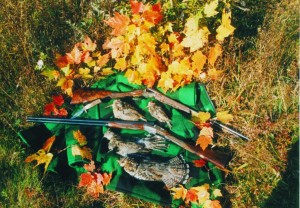 When I stepped in front of the dog, the woodcock came to the top of the whips and then headed away from me. I almost pulled the trigger just as the bird shucked to the right, but I waited and got back on the bird when it straightened out. It was a long shot but the bird dropped and as soon as we recovered it, I led them out of the cut into a stand of mature trees that we could easily walk through on the way back to the truck. I really didn’t need to break my two for two streak nor did I want to have them watch me hunt. A grouse find on our way back through the beeches was the icing on the cake as we ended the day with 29 woodcock and 13 grouse flushed. Since I had shot the last two birds in the bag that day, I really didn’t try and charge them double, but 42 birds flushed made for a great day.
When I stepped in front of the dog, the woodcock came to the top of the whips and then headed away from me. I almost pulled the trigger just as the bird shucked to the right, but I waited and got back on the bird when it straightened out. It was a long shot but the bird dropped and as soon as we recovered it, I led them out of the cut into a stand of mature trees that we could easily walk through on the way back to the truck. I really didn’t need to break my two for two streak nor did I want to have them watch me hunt. A grouse find on our way back through the beeches was the icing on the cake as we ended the day with 29 woodcock and 13 grouse flushed. Since I had shot the last two birds in the bag that day, I really didn’t try and charge them double, but 42 birds flushed made for a great day.
Reminiscing about those two Spanish guns has got me thinking about the guns I’ve shot woodcock with and there have been quite a few over the years, both mine and other peoples. As nice as the AYA #2 was it really doesn’t hold a candle to the Holland & Holland Royal Deluxe 20 that I once killed a grouse and a woodcock with. It made me nervous just holding it, say nothing of carrying it through the woods. None of the guns I’ve owned come even close. The one thing they all had in common was they worked just fine on both grouse and woodcock. The 12-gauge pump that I wore the bluing off of was replaced by an old 16-gauge German Sauer that had been very neatly bobbed with a hacksaw to give it sub-25” barrels. The Sauer was a little bit loose but without any choke it was lethal on woodcock. The Sauer went to friend when I swapped my last Brittany for a pristine 20-gauge 101 skeet gun and some cash. That Winchester accounted for an awful lot of birds over the years I carried it, and it too lost much of its bluing. But at closer to 7 than 6 pounds it seemed to get heavier as the years passed and I switched to a 28-gauge. First a Beretta, then a Huglu SxS, then back to a Beretta 686 all 28s.
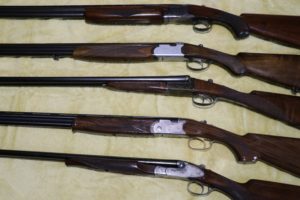 My most recently acquired gun is a 28-gauge (or should I say “bore” as it is an English gun) E J Churchill boxlock that tips the scale at just under 5-pounds and was built in 1898. And the first thing I did with it when I got it in late October was go to that big clearcut with a friend and one of his customer’s gun dogs that proceeded to point 10 woodcock and two grouse. It took me a few tries to get the feel of the gun but its first bird in my hands was a woodcock. As I write this, we are having a white Thanksgiving in Northern New Hampshire and the woodcock have been gone since just before Veteran’s Day. They’ll be back in the spring even before all the snow is gone, and I’ll be waiting for them.
My most recently acquired gun is a 28-gauge (or should I say “bore” as it is an English gun) E J Churchill boxlock that tips the scale at just under 5-pounds and was built in 1898. And the first thing I did with it when I got it in late October was go to that big clearcut with a friend and one of his customer’s gun dogs that proceeded to point 10 woodcock and two grouse. It took me a few tries to get the feel of the gun but its first bird in my hands was a woodcock. As I write this, we are having a white Thanksgiving in Northern New Hampshire and the woodcock have been gone since just before Veteran’s Day. They’ll be back in the spring even before all the snow is gone, and I’ll be waiting for them.
Woodcock Loads and Chokes
On one guided hunt, the sport showed up with a beautiful Filli. Rizinni 28 gauge that probably cost something north of $50k. It was a beautiful gun but he was using a “woodcock” load by a well-respected specialty shotshell company whose shells I use exclusively in my older English guns. My problem with this load, especially early in the season, is the extremely small #10 shot. Three quarters of an ounce of #10 shot has approximately 636 pellets whereas ¾ ounce of 7.5s only has around 254 pellets which is only 40% of the number of 10s. But it only takes a pellet or two to kill a woodcock and the problem is that the smaller the shot size the faster each pellet loses its energy.
Put simply, hitting a woodcock with a couple of 7.5 size pellets is going to kill a lot more birds than #10 shot at the same distance. In addition, grouse are likely to be found in many northern woodcock covers and #10 shot is really not enough for grouse. I have shot woodcock (and grouse) with 9s, 8s, 7.5s, and even 6s on occasion. After 40 years of this, I almost exclusively shoot 7.5s in all my guns. And I almost exclusively shoot standard velocity loads in the standard shot loads – ¾ oz. in 28, 7/8 oz. in 20, 1 oz. in 16, and 1 1/8 oz. in 12 gauge. The only exception is my almost 125-year-old 28 gauge that has 2 1/2” chambers in which I 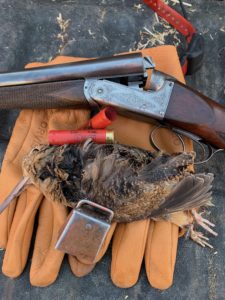 use 5/8 oz. load.
use 5/8 oz. load.
So, standard velocity 7.5s in whatever gauge you shoot is what I recommend to anyone that hunts with me. And then we have to have the choke discussion. I hunt exclusively behind pointing dogs and most of my shots are very close even on grouse. All my guns have open chokes. If they have screw-in chokes and two barrels, I put a skeet (or even cylinder) choke in the first barrel and something a little tighter in the second. For an older European Beretta that had fixed modified and full chokes when I got it, I sent it out and had it bored out to skeet and light modified. A number of my other fixed choke guns are skt/skt which is ostensibly the same thing.
The last bit of advice I’d give has to do with the type of shells I most often buy. Whenever possible I buy shells designed for target shooting which tend to have any manufacturers best components and hardest shot. The better the components and the harder the shot the more consistently the loads will pattern. Better patterns mean more pellets in the center of the pattern.
When it comes to what makes the best shotgun for woodcock – it’s whichever one you shoot best. I’ve shot them with pumps in 12 and 20, side-by-sides in 12, 16, 20, and 28, over/unders in 12, 20, and 28, and even an old single shot 28 with an exposed hammer. They all worked just fine

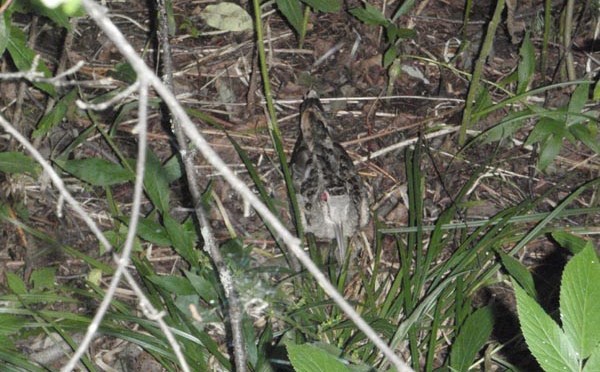
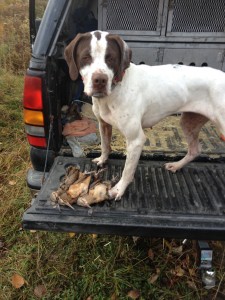
Thanks, I enjoyed your Confessions of a woodcock hunter.
You’re welcome.
Thanks I always enjoy stories that include information . enjoyed your tailgate food on our hunt also
It was a pleasure to read this. I remember Craig and I in 1987 racing after school to shoot birds with no dog (Craig could find birds as well as any dog). We knocked down many with his first dog Crew and many, many more thereafter. It was not long after that that Craig moved on from teaching English to teaching English setters (they listen better than high school students). The man knows his stuff and is a pleasure to have in the woods.
I thoroughly enjoyed your writing & photos. Thank you, Jack T. P.S: Dog: Brittany, Gun: Beretta S 687, 20 g, 28”, IC/M; Load: target, 2 3/4, 7 1/2.